Research Article - (2023) Volume 14, Issue 12
Abstract
The naturally occurring polyamine-spermine can be oxidised by serum amine oxidase to yield imino-dialdehydes. Similar dialdehydes can be synthesized chemically by treating diamines with chloro-propionaldehydes. The oxidation products are cytotoxic and inhibit the growth of cancer cells as well as human, animal and plant viruses. A synthetic imino-dialdehyde, containing a diamine-hexane moiety, was more active than the spermine oxidation product and inhibited the growth of influenza and Newcastle disease viruses. The positively charged imino-dialdehydes, cross cellular membranes, interact with cellular nucleic acids and form a biologically inactive complex. Viral vaccines are usually prepared by treating viruses with formalin, which interact with viral membrane proteins. Human and or animal viruses treated with imino-dialdehydes, retain viral membranes and are therefore potent immunogens. Vaccination of animals with influenza or Newcastle disease viruses, inactivated by imino-dialdehydes, gave better results compared to conventionally prepared vaccines. Cancer cells are rich in polyamines and treating these cells with amine-oxidases, results in the formation of cytotoxic imino-aldehydes. This approach can open new avenues in cancer chemotherapy, inactivating viruses and potent vaccines.
Keywords
Polyamines, Ornithine decarboxylase, Cancer, Imino-aldhydes
Introduction
Ever since the discovery in the eighteen century, spermidine and spermine and their diamine precursor, putrescine, have been associated with cell growth. They are aliphatic amines which are positively charged and are known collectively as the polyamines. The link between polyamines and cancer was well established when polyamines were detected in Ehrlich ascites cells (Bachrach U, et al., 1967) and elevated urinary polyamines were found in patients with a variety of tumors (Russell DH, 1971). As critical factors for cell growth and development, it is not surprising that these compounds are detected in tumor cells.
Ornithine Decarboxylase (ODC), the first enzyme in the polyamine biosynthetic pathway, exhibits increased enzyme activity in several cancers including breast prostate and colon (Russell DH and Snyder SH, 1968). Given the strong association between increased polyamine concentrations, elevated ODC activity and cancer, it was of interest to see if ODC inhibition could block cancer development.
Material and Methods
Synthesis of macromolecules
Escherichia coli was grown in glycerol-lactate medium and cells were incubated with H3-labelled uridine, thymidine or lysine. Reaction was stopped by the addition of trichloroacetic acid and the radioactivity in the precipitate was determined.
Detection of ODC
The presence of ODC in individual cells was quantitatively detected by an immune-fluorescence assay, using an ACAS 570 computerized fluorescence microscope. The enzyme was also detected by a quantitative immune-histochemical assay, using ODC antibody and a Fluorescein Isothiocyanate (FITC)-linked antibody.
Synthesis of imino-aldhydes
Imino-aldehydes are produced by incubating demines with chloral-propoinaldehyde-diethyl acetal of the oxalic acid salt. The diacetal was converted into the free aldehyde by incubating for 3 hours at 37°C with 0.05 N Sulphuric acid (H2SO4), followed by neutralization with 1 N Sodium Hydroxide (NaOH).
SolubilizedSendai viruses
Sendai virus particles were solubilized by detergents like Triton X-100. The nuclear fractions in the solubilized mixtures are removed by centrifugation and amine oxidases are added to the fractionized membranes. Dialysis, removed the detergents and stable particles containing amine oxidases, were obtained.
Results and Discussion
Targeting the polyamine pathway and chemotherapy
α-Difluoromethyl Ornithine (DFMO) was one of the first inhibitors (Figure 1) of ODC activity (Takigawa M, et al., 1983). Despite its success in vitro in several tumor cell types, it proved to be less effective in vivo and in clinical trials. Apparently, compensatory mechanisms occur to increase polyamine cellular pools. On the other hand, DFMO can be used to prevent diseases (chemoprevention).
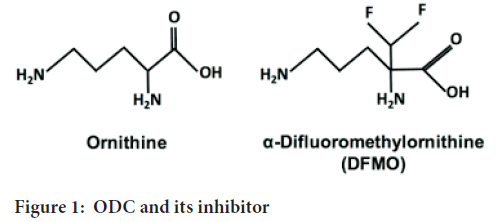
Figure 1: ODC and its inhibitor
Amine oxidases
Polyamines are oxidized by various enzymes derived from different sources, including plants, pea seedlings and bacteria. Of all these enzymes, plasma amine oxidase has been the subject for the most extensive studies. The properties of this enzyme, its purification and the possible functions of amine oxidases were discussed in great details by Tabor CW, et al., 1954.
The plasma or serum of many ruminants, contain an enzyme which oxidized polyamines and benzylamine (but not diamines). The mechanism of polyamine oxidase by plasma amine oxidase was studied by Tabor CW, et al., 1964 (Figure 2). Because of the liability of the oxidation products (Figure 2), they have to be used immediately after production or be stabilized. To study the biological activity of the oxidation product, catalase should be added to the system, to eliminate the presence hydrogen peroxide.
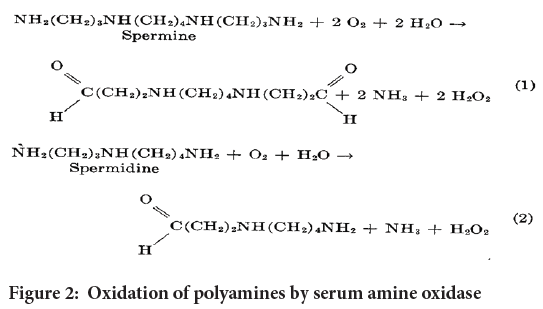
Figure 2: Oxidation of polyamines by serum amine oxidase
Imino-aldehydes
POX-3, (Figure 3), in the form of diacetal of oxalic acid salt was synthesized in our laboratory by Dambrovitz A. or purchased from Fine Organics Inc. Lodi, New Jersey, The diacetal was converted into the free aldehyde by incubating at 37°C for 3 hours with 0.05 N H2SO4, followed by neutralization with 1 N NaOH.

Figure 3: Diacetal oxalic acid salt
Bacteria
Escherichia coli was grown to a density of 2 × 108 cells/ml, incubated for 25 minutes with the imino-aldehyde (POX-3) and the radioactive precursors of macromolecular synthesis (Bachrach U and Rosenkranz HS, 1969). Results are described in Table 1. It may be seen that the synthesis of RNA, DNA and proteins was inhibited by 75%-99%.
| Cultured cells | Control (cpm) | POX-3 (cpm) | Inhibition (%) |
|---|---|---|---|
| (3H)-uridine incorporation | 73,309 | 770 | 99 |
| (3H)-TPM (Total productive maintenance) incorporation | 2,592 | 399 | 84.5 |
| (3H)-lysine incorporation | 3,153 | 789 | 75 |
Table 1: Inhibition of growth
Viruses
The oxidation products of polyamines are highly cytotoxic. They are anti-cancer (Averill-Bates DA, et al., 2005; Bachrach U, et al., 1967) and inhibit bacterial growth (Bachrch U and Persky S, 1964). Various antibacterial and anticancer agents are known, but our arsenal to combat viral diseases is rather limited. It was therefore of interest to find out whether polyamines can also inhibit the growth of viruses. Bacterial viruses (bacteriophages), infect bacteria such as Escherichia coli which grows easily. It is therefore not surprising that the phage-bacteria system served as an early model to study antiviral activities of oxidized polyamines (Figure 4).
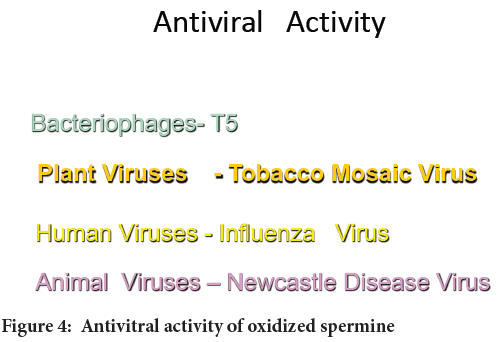
Figure 4: Antivitral activity of oxidized spermine
Bacterial viruses
It soon became apparent that bacteriophages differ in their susceptibility to oxidized spermine (Figure 5). Bacteriophages of the T-odd series were sensitive, while those of the T-even series were resistant (Bachrach U, et al., 1963). This can be explained by the known fact, that coliphages of the T-odd series are permeable, unlike the coliphages of the T-even series. This would imply that oxidized polyamines have to penetrate in O-phage heads, to exert cytotoxicity.
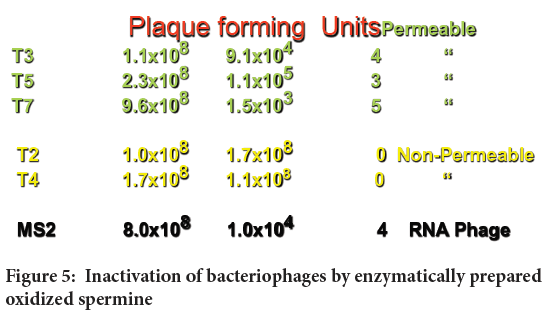
Figure 5: Inactivation of bacteriophages by enzymatically prepared oxidized spermine
Anti-viral activity
After finding that T5 coliphages are inactivated by oxidized spermine, we studied the sensitivity of different viruses to oxidized spermine. It may be seen that after exposing the viruses to oxidized spermine for 3 hours, the infectivity was reduced by log 1-4 (Table 2).
| Virus | Inactivation log10 |
|---|---|
| Influenza virus | 2 |
| Newcastle disease | 2 |
| West Nile | 4 |
| Sindbis | 4 |
Table 2: Inactivation of viruses by oxidized spermine
Plant viruses
After finding that permeable coliphages are inactivated by oxidized polyamines, plant viruses were examined. These included Potato virus X (PVX), Tobacco mosaic Virus (TMV) and Alfafa mosaic Virus (AMV).
When TMV viruses were treated with enzymatically-prepared oxidized spermine (100 µg/ml) for 3 hours and then rubbed on tobacco leaves (Bachrach U, et al., 1965), only 5% of the control lesions were detected (Figure 6). Oxidized polyamines had no deleterious effect on plant leaves. This is a very important finding, as only a few drugs can form germ-free tobacco plants.
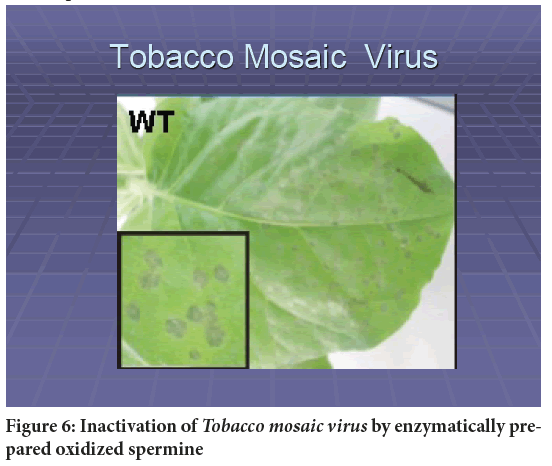
Figure 6: Inactivation of Tobacco mosaic virus by enzymatically prepared oxidized spermine
Human viruses
When influenza viruses, were incubated for 24 hours with oxidized spermine (1.65 µg/ml) and then exposed to chick red blood cells, the inactivated viruses retained their property to hemagglutinate. Oxidized polyamines, interact with cellular nucleic acids and form a biological inactive complex. Viral vaccines are usually prepared by treating viruses with formalin, which interact with viral membrane proteins. Human and/or animal viruses treated with imino-dialdehydes, retain unchanged viral membranes and are therefore potent immunogens (Figure 7and Table 3). Vaccination of animals with influenza or Newcastle disease viruses, inactivated by imino-dialdehydes, gave better results compared to conventionally prepared vaccines. This opens new possibilities to improve vaccination processes.
| Preparation | Antibody titer (units) |
|---|---|
| Live virus | 1,280 |
| Oxidized spermine 1.65 µ/mol/ml | 1,280 |
| Formaldehyde | |
|
853 480 |
| Glutaraldehyde (3.3 µ/mol/ml) | 970 |
Table 3: Immune response after injecting live or inactivated influenza virus into mice
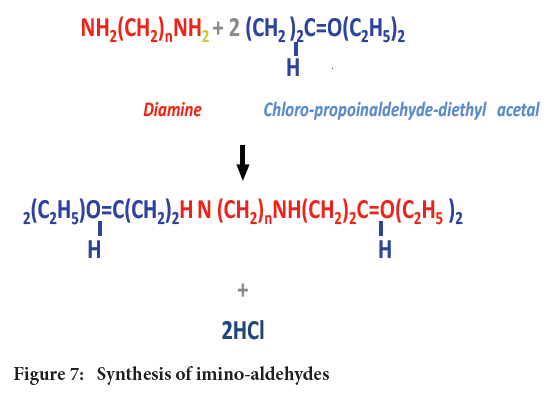
Figure 7: Synthesis of imino-aldehydes
Newcastle disease virus
Newcastle disease viruses were treated with oxidized polyamines with different structures. This included enzymatically prepared oxidized spermine and synthetic compounds containing central chains with 4 or 6 carbons. The cytotoxicity of the different compounds was compared.
It may be seen that the compound with diamino-hexane, was the most potent one and after 1 hour the viability of the viruses was reduced by 3.3 log10 (Table 4). The synthetic compound with a diamino-butane chain was also very active. It may be concluded hat cytotoxicities of synthetic oxidized polyamines can be modified by changing their composition and can be applied in the control of viral growth.
| Time (hours) | Compound (0.8 mM) | P.F.U/ml | Inactivation (log10) |
|---|---|---|---|
| 0 | - | 8.7 × 107 | - |
| 1 | oxidized spermine (enzymatic) | 8.2 × 106 | 1 |
| 3 | oxidized spermine (enzymatic) | 4.4 × 104 | 3.3 |
| 5 | oxidized spermine (enzymatic) | 2.5 × 102 | 5.5 |
| 1 | oxidized spermine (synthetic) | 4.7 × 104 | 3.3 |
| 3 | oxidized spermine (synthetic) | 10 | 6 |
| 5 | oxidized spermine (synthetic) | 0 | 7 |
| 1 | diamino-hexane | 1.2 × 104 | 3.8 |
| 3 | diamino-hexane | 10 | 6 |
Note: P.F.U: Plaque Forming Units Oxidized polyamines were incubated with viruses at 37°C for 3 hours
Table 4: Inactivation of Newcastle disease viruses by imino-aldehydes
Polyamines and carcinogenesis
Gene therapy: Cancer cells are rich in polyamines and these polycations can be oxidized by serum amine oxidase to yield cytotoxic products (Tabor CW, et al., 1964). Based on these considerations, it is conceivable that cancer cells could be inactivated preferentially, as they contain polyamines, which are the substrates of amine oxidases. Normal, cells, which contain only small amounts of polyamines, should not be affected by the injected enzyme.
Sendai viruses can be solubilized by detergents. Removal of the detergent leads to the formation of empty reconstituted virus envelopes. When soluble macromolecules are present in the detergent-solubilized fraction, they are trapped within resealed envelopes, reconstituted after the removal of the detergent (Figure 8).

Figure 8: Flowchart for micro-injection of amine oxides
Bovine serum amine oxidases were trapped within reconstituted Sendai envelopes and they retained their activity (Table 5). Sendai viruses were used to inhibit the growth of cancer-bearing cells. Viruses were disintegrated by detergents and viral envelopes were separated from nuclear nuclei by centrifugation. Amine oxidases were trapped within reconstituted Sendai viruses and retained their activities. Reconstituted viral particles were injected into cultured fibroblasts of chick or rat embryos (Figure 9). As expected, cells rich in polyamines (transformed fibroblasts of chick or rat embryos), were more susceptible to the injected oxidases, rather than others which contain less polyamines.
| Culture | Incorporation (ct/min/culture dish) | |
|---|---|---|
| Thymidine | Leucine | |
| Normal cells | 11,500 | 12,000 |
| Normal cells+microinjected oxidases | 10,800 | 10,000 |
| Transformed cells | 10,125 | 10,000 |
| Transformed cells+microinjected oxidases | 3,800 | 3,200 |
Table 5: Effect of microinjected amines and diamine oxidases on the ultrastructure of eukaryotic cultured cells
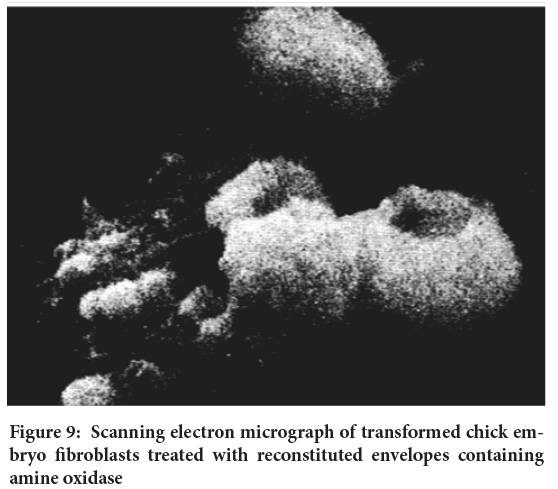
Figure 9: Scanning electron micrograph of transformed chick embryo fibroblasts treated with reconstituted envelopes containing amine oxidase
When reconstituted viruses were incubated with chick embryo fibroblasts, transformed by Rous sarcoma virus, deformations and holes were observed in the fibroblasts. The shape of normal eukaryotic cells was not affected by reconstituted Sendai viruses (Bachrach U, et al., 1987). Immobilized bovine serum oxidase was also used by other investigators. The group of Agostinelli (Bachrach U, et al., 1987; Averill-Bates DA, et al., 2005) prepared poly-ethylene glycol particles containing bovine serum amine oxidase. These, were injected into mice carrying B16 tumor cells. A significant arrest of tumor growth was observed.
The group of Mondovi (Stevanato R, et al., 1989) also prepared immobilized serum amine oxidase particles.
Polyamines are a marker of proliferation and ornithine decarboxylase is an early possibly obligatory event in carcinogenesis (O’brien TG, 1976). Interference in their activities may arrest of growth. Imino-aldehydes block the activity of polyamines (Table 3) and therefore may be regarded as a chemopreventive agent. α-Difluoromethyl Ornithine (DFMO), inhibits the activity of ornithine decarboxylase and has been used to suppress the outbreak of prostate malignancies (Meyskens FI and Gerner EW, 1999). It appears that immobilized amine oxidases have a potential therapeutic value. The inert liposomes, used for trapping the enzymes have an advantage, by not being antigenic and do not trigger the production of immunological reactions. On the other hand, the reconstituted viral envelopes can be targeted and therefore be more potent and specific. Chemoprevention should be regarded as in important tool to combat cancer and should be applied widely.
Conclusion
Polyamines are oxidized by serum amine oxidase, yielding unstable cytotoxic amino-aldehydes. These compounds, inhibit the growth of bacteria, plant, animal and human viruses. Their anti-cancer activity was also reported. Stable imino-alehydes were synthesized. They contained acetal groups, which protected aldehyde regions. The central chains of these synthetic stable compounds contained 4 or 6 carbons. They were very active and inhibited the growth of influenza viruses and may be the basis for improved vaccination processes. Serum amine oxidases were trapped within reconstituted Sendai virus envelopes and injected into normal and transformed fibroblasts. The growth of cancer cells was preferentially inhibited; this may be defined as an example of “gene therapy”. The synthetic imino-aldehydes also prevented carcinogenesis and may play a role as a chemopreventive agent.
It may be concluded that polyamines and their biologically and synthetic derivatives are biologically active and may contribute to the improvement of vaccination, gene therapy and chemoprevention.
References
- Bachrach U, Abzug S, Bekierkunst A. Cytotoxic effect of oxidized spermine on Ehrlich ascites cells. Biochimica et Biophysica Acta. 1967; 134(1): 174-181.
- Russell DH. Increased polyamine concentrations in the urine of human cancer patients. Nat New Biol. 1971; 233(39): 144-145.
[Crossref] [Google Scholar] [Pubmed]
- Russell D, Snyder SH. Amine synthesis in rapidly growing tissues: Ornithine decarboxylase activity in regenerating rat liver, chick embryo, and various tumors. Proc Natl Acad Sci U S A. 1968; 60(4): 1420-1427.
[Crossref] [Google Scholar] [Pubmed]
- Takigawa M, Verma AK, Simsiman RC, Boutwell RK. Inhibition of mouse skin tumor promotion and of promoter-stimulated epidermal polyamine biosynthesis by α-difluoromethylornithine. Cancer Res. 1983; 43(8): 3732-3738.
[Google Scholar] [Pubmed]
- Tabor CW, Tabor H, Rosenthal SM. Purification of amine oxidase from beef plasma. J Biol Chem. 1954; 208(2): 645-661.
[Crossref] [Google Scholar] [Pubmed]
- Tabor CW, Tabor H, Bachrach U. Identification of the aminoaldehydes produced by the oxidation of spermine and spermidine with purified plasma amine oxidase. J Biol Chem. 1964; 239(7): 2194-2203.
[Crossref] [Google Scholar] [Pubmed]
- Bachrach U, Rosenkranz HS. Inhibition of bacterial macromolecular syntheses by the polyamine POX-3. Biochem Pharmacol. 1969; 18(1): 243-246.
[Crossref] [Google Scholar] [Pubmed]
- Averill-Bates DA, Chérif A, Agostinelli E, Tanel A, Fortier G. Anti-tumoral effect of native and immobilized bovine serum amine oxidase in a mouse melanoma model. Biochem Pharmacol. 2005; 69(12): 1693-1704.
[Crossref] [Google Scholar] [Pubmed]
- Bachrach U, Persky S. Antibacterial action of oxidized spermine. J Gen Microbiol. 1964; 37(2): 195-204.
[Crossref] [Google Scholar] [Pubmed]
- Bachrach U, Tabor CW, Tabor H. Inactivation of bacteriophages by oxidized spermine. Biochim Biophys Acta. 1963; 78(4): 768-770.
[Crossref] [Google Scholar] [Pubmed]
- Bachrach U, Rabina S, Loebenstein G, Eilon G. Antiviral action of oxidized spermine-inactivation of plant viruses. Nature. 1965; 208(5015): 1095-1096.
[Crossref] [Google Scholar] [Pubmed]
- Bachrach U, Ash I, Rahamim E. Effect of microinjected amine and diamine oxidases on the ultrastructure of eukaryotic cultured cells. Tissue Cell. 1987; 19(1): 39-50.
[Crossref] [Google Scholar] [Pubmed]
- Bachrach U, Ash I, Abu‐Elheiga L, Hershkovitz M, Loyter A. Fusion‐mediated microinjection of active amine and diamine oxidases into cultured cells: Effect on protein and DNA synthesis in chick embryo fibroblasts and in glioma cells. J Cell Physiol. 1987; 131(1): 92-98.
[Crossref] [Google Scholar] [Pubmed]
- Stevanato R, Porchia M, Befani O, Mondovi B, Rigo A. Characterization of free and immobilized amine oxidases. Biotechnol Appl Biochem. 1989; 11(3): 266-272.
[Crossref] [Google Scholar] [Pubmed]
- O'brien TG. The induction of ornithine decarboxylase as an early, possibly obligatory, event in mouse skin carcinogenesis. Cancer Res. 1976; 36(7_Part_2): 2644-2653.
[Google Scholar] [Pubmed]
- Meyskens Jr FL, Gerner EW. Development of Difluoromethylornithine (DFMO) as a chemoprevention agent. Clin Cancer Res. 1999; 5(5): 945-951.
[Google Scholar] [Pubmed]
Author Info
Uriel Bachrach*Citation: Bachrach U: Imino-Aldehydes-A New Tool to Combat Cancer and Viral Diseases
Received: 27-Nov-2023 Accepted: 11-Dec-2023 Published: 18-Dec-2023, DOI: 10.31858/0975-8453.14.12.742-746
Copyright: This is an open access article distributed under the terms of the Creative Commons Attribution License, which permits unrestricted use, distribution, and reproduction in any medium, provided the original work is properly cited.
ARTICLE TOOLS
- Dental Development between Assisted Reproductive Therapy (Art) and Natural Conceived Children: A Comparative Pilot Study Norzaiti Mohd Kenali, Naimah Hasanah Mohd Fathil, Norbasyirah Bohari, Ahmad Faisal Ismail, Roszaman Ramli SRP. 2020; 11(1): 01-06 » doi: 10.5530/srp.2020.1.01
- Psychometric properties of the World Health Organization Quality of life instrument, short form: Validity in the Vietnamese healthcare context Trung Quang Vo*, Bao Tran Thuy Tran, Ngan Thuy Nguyen, Tram ThiHuyen Nguyen, Thuy Phan Chung Tran SRP. 2020; 11(1): 14-22 » doi: 10.5530/srp.2019.1.3
- A Review of Pharmacoeconomics: the key to “Healthcare for All” Hasamnis AA, Patil SS, Shaik Imam, Narendiran K SRP. 2019; 10(1): s40-s42 » doi: 10.5530/srp.2019.1s.21
- Deuterium Depleted Water as an Adjuvant in Treatment of Cancer Anton Syroeshkin, Olga Levitskaya, Elena Uspenskaya, Tatiana Pleteneva, Daria Romaykina, Daria Ermakova SRP. 2019; 10(1): 112-117 » doi: 10.5530/srp.2019.1.19
- Dental Development between Assisted Reproductive Therapy (Art) and Natural Conceived Children: A Comparative Pilot Study Norzaiti Mohd Kenali, Naimah Hasanah Mohd Fathil, Norbasyirah Bohari, Ahmad Faisal Ismail, Roszaman Ramli SRP. 2020; 11(1): 01-06 » doi: 10.5530/srp.2020.1.01
- Manilkara zapota (L.) Royen Fruit Peel: A Phytochemical and Pharmacological Review Karle Pravin P, Dhawale Shashikant C SRP. 2019; 10(1): 11-14 » doi: 0.5530/srp.2019.1.2
- Pharmacognostic and Phytopharmacological Overview on Bombax ceiba Pankaj Haribhau Chaudhary, Mukund Ganeshrao Tawar SRP. 2019; 10(1): 20-25 » doi: 10.5530/srp.2019.1.4
- A Review of Pharmacoeconomics: the key to “Healthcare for All” Hasamnis AA, Patil SS, Shaik Imam, Narendiran K SRP. 2019; 10(1): s40-s42 » doi: 10.5530/srp.2019.1s.21
- A Prospective Review on Phyto-Pharmacological Aspects of Andrographis paniculata Govindraj Akilandeswari, Arumugam Vijaya Anand, Palanisamy Sampathkumar, Puthamohan Vinayaga Moorthi, Basavaraju Preethi SRP. 2019; 10(1): 15-19 » doi: 10.5530/srp.2019.1.3






